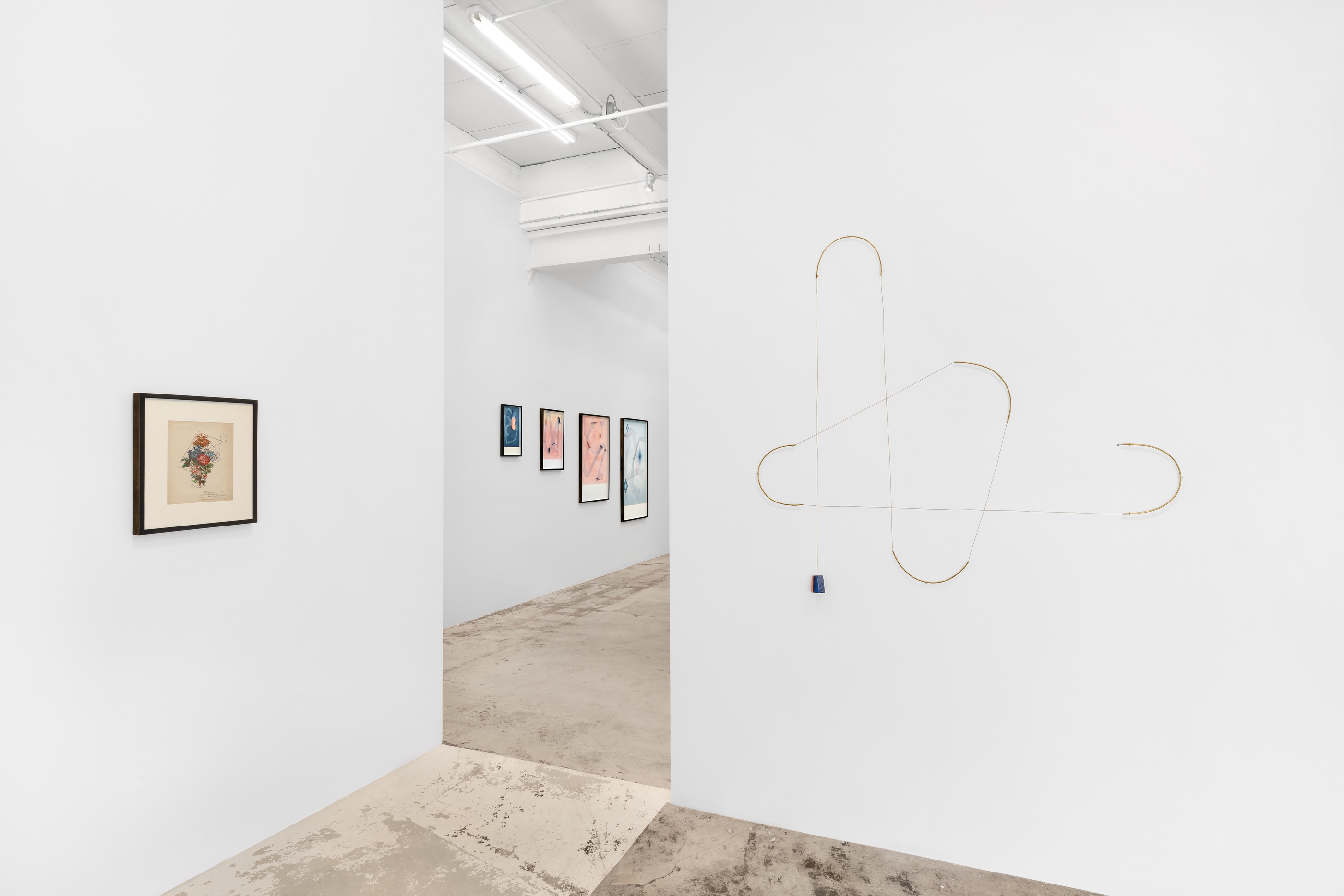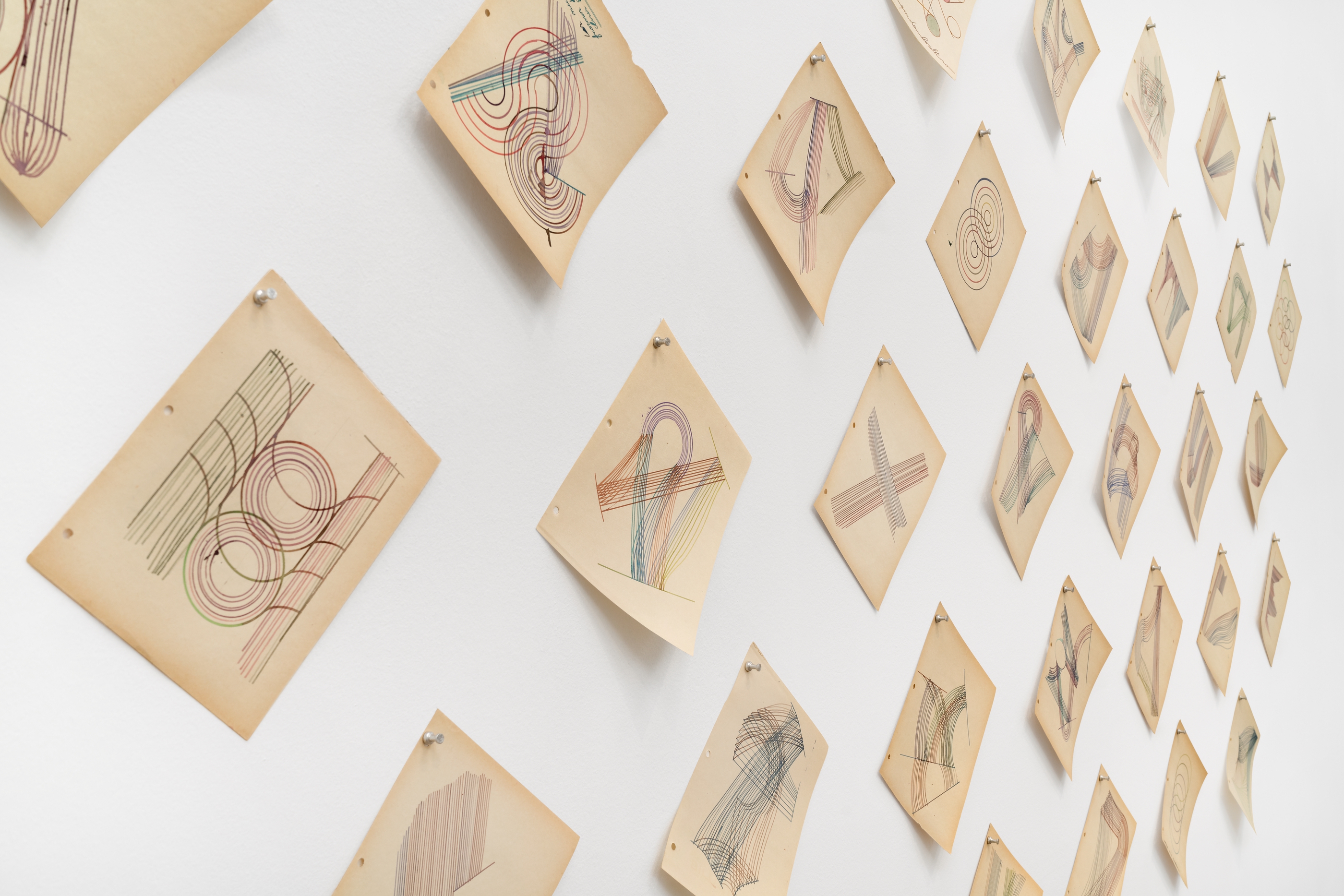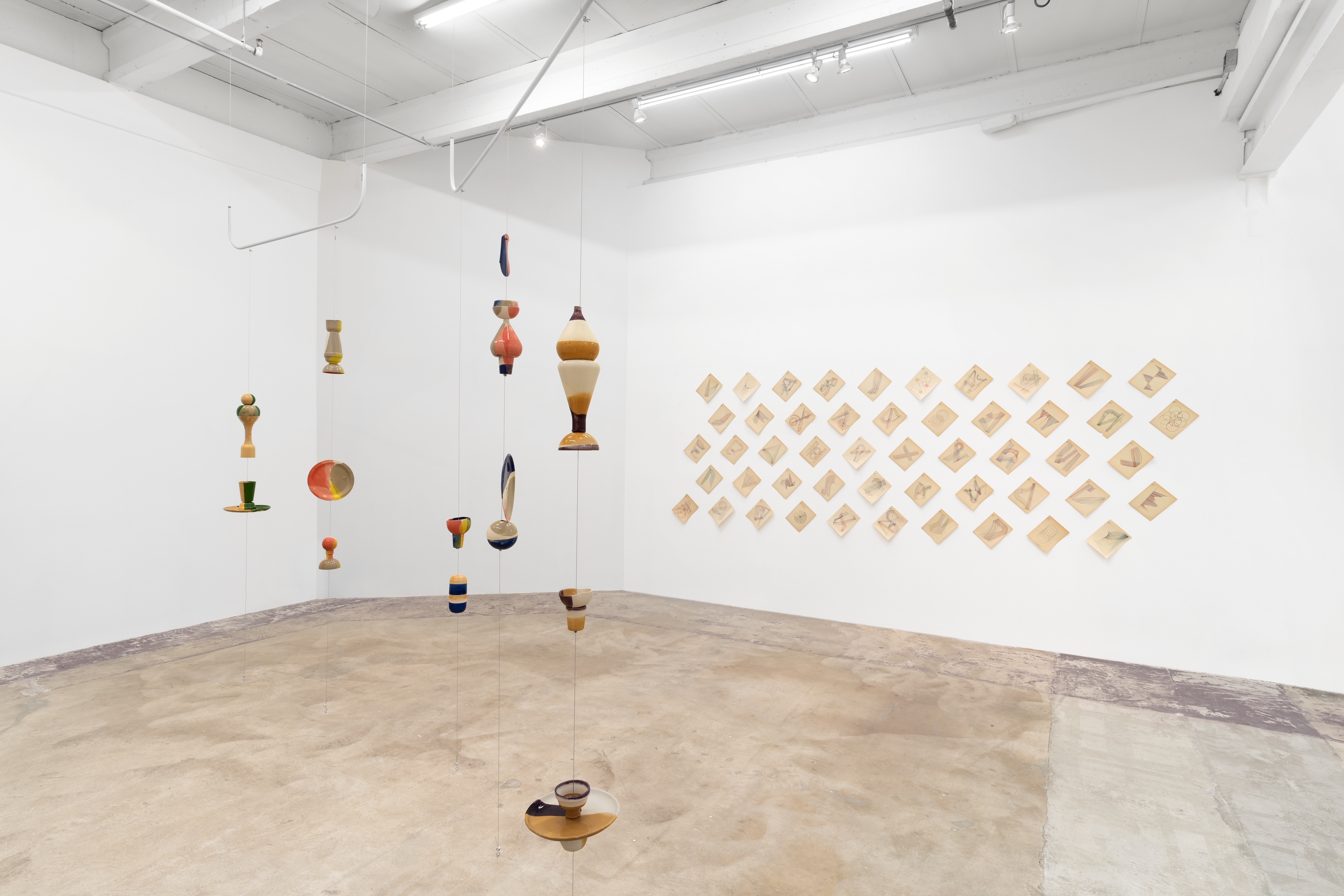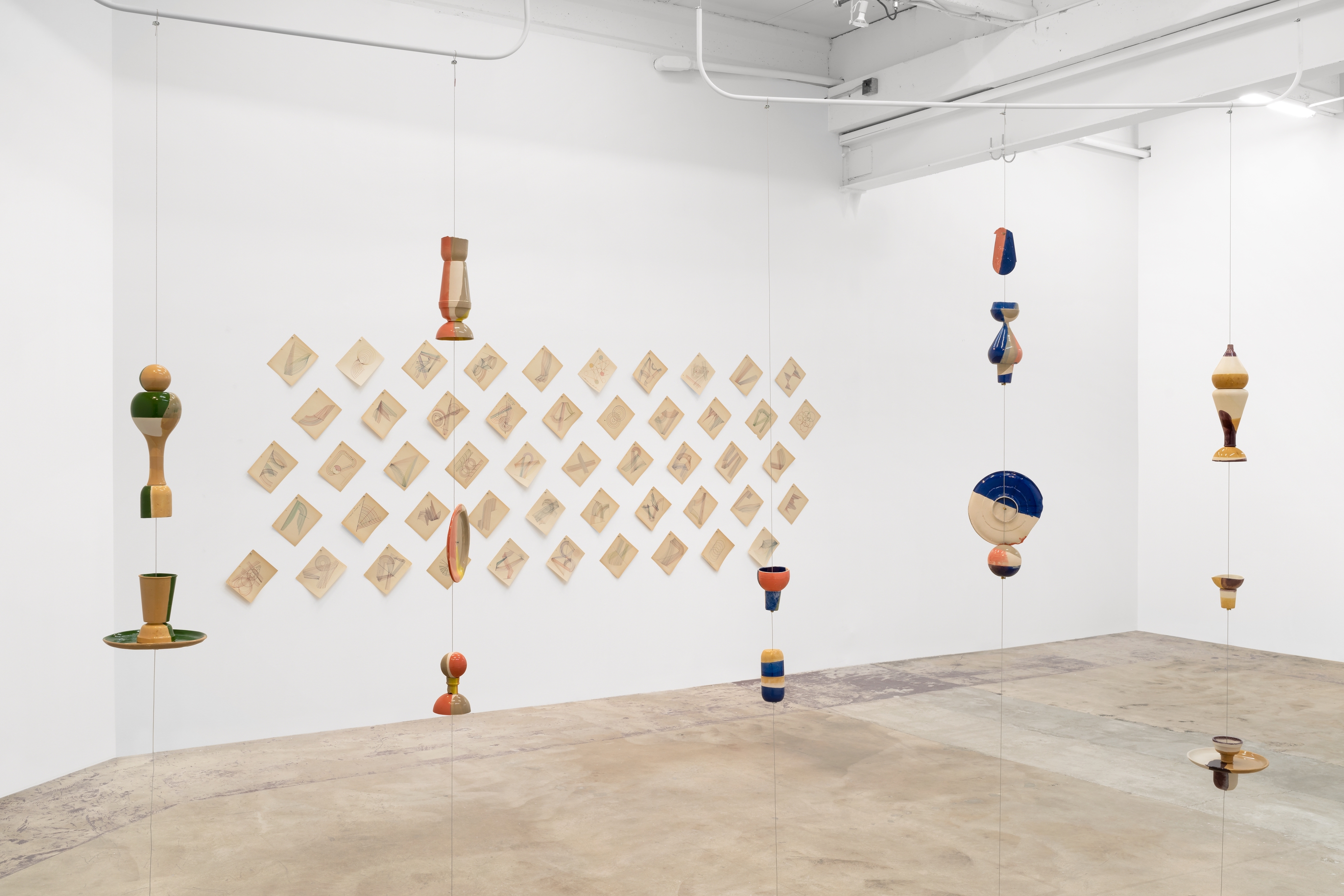AMADEO AZAR
THE SEA IS A RAIN OF VOICES
(El mar es una lluvia de voces)
October 2 — November 13, 2022
Text by Jennifer Inacio
![]()
![]()
![]()
![]()
![]()
![]()
![]()
![]()
![]()
![]()
![]()
Dot Fiftyone Gallery is delighted to announce the exhibition “The Sea is a rain of voices”, the first solo show of artist Amadeo Azar with the gallery.
Working across various mediums, including watercolor, painting, video, sound, and most recently, ceramics, Amadeo Azar (b. 1972, Mar del Plata, Argentina) examines the intersections of history, modernism, and architecture within the socio-political dynamics of his native Argentina. For Azar's first exhibition at Dot Fiftyone, The Sea is a Rain of Voices presents interconnected artworks that encourage new associations between sound and image while also exploring relevant moments within his country's history.
As one enters the gallery, they are immediately welcomed by The Sea I and The Sea II, 2022, an interactive installation composed of bronze thread, bronze pipes, and glazed ceramic cups. The thread travels through the wall, creating a different abstracted composition on the opposite side. Mimicking a string phone with one ceramic piece on each end of the thread, this interactive work is a personal reference to a device that Azar built to communicate with his son through the walls that divided their bedrooms.[1] Although there are many layers of historical references, in addition to personal curiosities within his practice, his aim has often been to use them as "fertilizer to develop poetics"[2] instead of merely using them to illustrate ideas. The Sea I and The Sea II set the tone for how the artist invites visitors to explore this exhibition and develop their own poetics. With a genuine gesture, Azar welcomes us to communicate and dialogue with his universe of interests, explorations, and creations.
When walking beyond the entrance wall, viewers enter a space with watercolors, ceramics, and sound. To create these works and many others within his practice, Azar begins his process by developing conceptual maps that intertwine artistic, historical, and social-political observations. The technical and meticulous watercolors—framed and on vintage paper—are visual translations of the chaotic yet, organized energy generated from Azar's maps. These could almost be interpreted as fast-moving neurons while they attempt to connect and transfer the energy from one idea to another. These watercolors' sensuous curves and movements begin to simulate sound waves and frequencies that move harmoniously inside their compositions. Slowly, Azar transforms sound and movement into a tactile element within our imaginative consciousness.
Viewers are also greeted by the ceramic installation The Distance, 2022 in the gallery's central space. By using functional objects such as molds—such as cups, plates, bowls, and vases—the artist was able to produce the ceramic pieces found interlaced with steel cable and tubular structures. Painted with minimalist and modern patterns with a palette parallel to other works in the gallery, these ceramic pieces are also used to produce the sound heard in the video The Sea is a Rain of Voices, 2022. Azar is not only successfully weaving his topics of interest seamlessly within his conceptual maps, but he also knits the body of work for this exhibition tightly through weaving mediums, compositions, and palettes.
In the back room, we are presented with the video The Sea is a Rain of Voices, which gives the title for the exhibition. Contrary to the open-ended narrative works in the exhibition, this video is a compilation of specific visuals, historical references, materials, and tools that Azar used to create the objects seen in the gallery. At the beginning of the recording, viewers are presented with the historic publication La Nación Argentina. Justa, Libre, Soberana (1950)—a propagandist and encyclopedic book advertising significant developments from 1943 to 1950 that Argentinian president Juan Domingo Perón generated. One of these propositions, which is referenced in the video, is the Huemul Project—a research funded by the Peron government where former Nazi and researcher Ronald Richter assured he could produce limitless nuclear energy for the country.[3] Following the failure of the utopian program, the machines for the project were used to create a physics institute in 1955; however, the thread of this historic reference goes deeper in Azar's video. We also see images of the machines developed by Fernando von Reichenbach—a pioneer in sound investigation and Director of Technology at the Instituto Torcuato Di Tella. In 1967, he built the Analog Graphic Converter, an instrument capable of synthesizing sounds from drawings done on a paper roll.[4] The irony of the failed and problematic Huemul project in the 50s is that it flourished into a functioning and valuable physics institute, which then produced the synthesizers used in Reichenbach's sonic machines and acoustic-electronic experimentations. This web of connections and overlap in history is what fuels Azar's research and curiosity and drives him to produce his artworks.
By revisiting critical moments that emerged in the utopias and ideologies of 20th-century Argentina, Azar explores how the political implications of these events intersect with aesthetic elements. He challenges the viewer to examine how a flow of historical references can transform into a symphony of sounds, synchronized drawings, and ceramics that become instruments of sound or tools for communication. Infused with meticulous techniques, carefully arranged compositions, and open-ended narratives, the interconnected works in this exhibition offer a glimpse of how non-linear narratives formulate within Azar's practice.
Jennifer Inacio
Associate Curator at Pérez Art Museum Miami (PAMM)










Amadeo Azar (b. 1972, Mar del Plata, Argentina) has had solo exhibitions in the Museo de Arte Contemporáneo de Salta, Argentina; Centro Cultural de la Memoria Harold Conti, Buenos Aires; Centro Cultural Recoleta, Buenos Aires; and in galleries located in Mexico City, Miami, Cádiz, and Buenos Aires. In addition, he has participated in group exhibitions in numerous institutions, including The Drawing Center, New York; Queens Museum, New York; Fundación Federico Klemm, Buenos Aires; Museo de Arte Contemporáneo, Buenos Aires; Fundación Fortabat, Buenos Aires; amongst others. Azar has received the Pollock Krasner Foundation and the Fondo Nacional de las Artes awards. His works are in various public, including Phoenix Art Museum; Cleveland Clinic, Cincinnati; Related Group/Perez Collection, Miami; Deutsche Bank Collection, New York; Museo de Arte Contemporáneo de Rosario; Fundación Federico Klemm; Fondo Nacional de las Artes; Fundación Banco Supervielle; Fundación Banco Nación, Argentina; as well as in private collections in Latin America, the United States, and Europe.
Click here to watch the artist at his studioClich here for a walktrough of the show
[1] Amadeo. Azar, in conversation with author, August 19, 2022.
[2] Amadeo Azar, http://abstractioninaction.com/artists/amadeo-azar/
[3] Robert Kidd, "I'll Give You Fusion in a Bottle," New Scientist 231, No. 3087, 38 (August 2016).
[4] Dr. Ricardo Dal Farra, “Who tells History?,” https://isea-archives.siggraph.org/presentation/who-tells-history/


